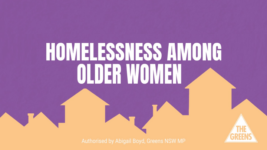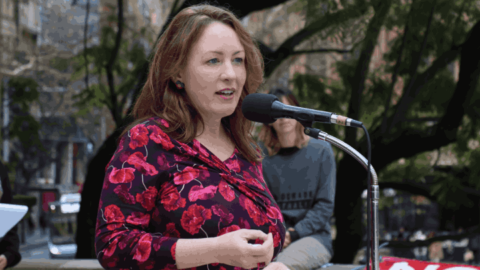Older Women Are the Fastest Growing Cohort of Homeless, Explains Greens MLC Abigail Boyd

Research released on Tuesday outlines that based on the 2021 Census there are currently around 640,000 households nationwide with housing needs that aren’t being met, and based on projected growth, this is set to increase to 940,000 households by the year 2041.
By needs not being met, these low-income households on census night last year were experiencing homelessness or living in overcrowded accommodation or spending over 30 percent of their income on housing.
Carried out by the UNSW City Futures Research Centre on behalf of the Community Housing Industry Association, the Quantifying Australia’s Unmet Housing Need report will be used to inform a meeting this Friday set to deliberate upon the Albanese government’s new Housing Accord.
The federal government scheme proposes 1 million new homes be built over the five years commencing 2024, which will include non-market housing, meaning social or affordable housing.
That Australia is experiencing an affordable housing crisis is well understood, and this is what the Labor government’s new accord aims to address.
However, none of the data released this week sets out that there’s a growing homelessness crisis amongst older people in the community, and the fastest growing cohort of people with no fixed address in the country is women over the age of 55.
A lack of housing and services
On releasing its report in October, the NSW Legislative Council inquiry into homelessness amongst those over 55 years old was well aware of this growing issue for older women in this state.
Indeed, it found “an upward trajectory of older people experiencing homelessness”, “in particular women”.
Although, the full extent of homelessness amongst older women in NSW remains unknown as much of it is hidden, because most of these women are not sleeping on the streets, and instead are existing in “highly precarious situations”, such as couch surfing or sleeping in their cars.
The inquiry further found that the single biggest factor driving this growing older population of homeless people, and especially that of women, is the increasing shortage of social and affordable housing available on the market.
And while the specialist homelessness services sector is drastically underfunded and struggling, it’s not having to adjust to the increasing number of older homeless people in this state, as they don’t seem to be engaging with such services.
Housing First
NSW Greens MLC Abigail Boyd initiated the inquiry into the growing number of older women experiencing homelessness earlier this year, and she served as deputy chair on the inquiry committee, which delivered 40 recommendations on how to improve this crisis.
The inquiry further highlighted the success of the Housing First approach, which not only aims to secure a person housing but also provides wraparound services to support them in staying there. And it recommended that the NSW government incorporates these principles into all of its policies.
Sydney Criminal Lawyers spoke to Abigail Boyd about why older women are increasingly facing homelessness, the dearth in affordable housing, and how she considers the inquiry delivered a comprehensive blueprint to address this issue that will more than likely be taken up by government.

Abigail, broadly speaking, why are women over 55, in particular, the fastest growing sector of society finding themselves without secure housing?
We’ve seen a general trend towards older people finding themselves homeless, but in respect of women, there are a couple of things that make it even more likely that they will find themselves in housing stress and, consequently, perhaps homeless.
Firstly, women have lower levels of superannuation and financial security because they tend to take time out of work while they’re having children, but also because their pay is significantly lower than men’s.
So, when women get to an older age, it doesn’t take much for them to suddenly find themselves homeless, particularly if their partner passes away, or if they get divorced or lose their job.
And the second aspect that we found was particularly impacting on women is domestic violence.
So, a lot of women get to the point where their children have left home and they decide it’s not safe to be living in the house that they’ve been living in, and when they try to leave, it’s incredibly hard for them to get the help that they need.
The report sets out that much of this homelessness is hidden, as many of these older women can find themselves in situations where they’re doing things such as couch surfing.
But if you walk through the Sydney CBD streets, rising homelessness amongst older women is quite noticeable. Still many people are shocked when they’re confronted with this fact.
Did the inquiry find that growing homelessness amongst older women reflects some sort of change in societal values?
No. Growing homelessness amongst women is more a factor of policy settings of successive governments catching up with us.
So, when we talk about older women being the hidden homeless, that’s very gendered in its basis, because if you look at the comparative safety of a woman sleeping rough on the streets versus a man, that explains why we have far more men on the streets.
I’m not sure whether some of the understanding of a rising number of older women becoming homeless is because we previously didn’t understand hidden homelessness, or whether it’s just gotten to the stage where there are even fewer places for women to remain hidden when they’re homeless.
When I’m talking about policy settings, even for those people who have a roof over their heads, we know that because of policy settings from governments around housing and investment, we do have a huge number of people in housing stress.
Research that came out just today shows that there could be up to a million people in housing stress over the next couple of decades, which underlines the need to change those policy settings.
And how adequate did the inquiry find the specialist homelessness service sector is in relation to this growing cohort of older women experiencing homelessness? Has the service sector reformed in any way to reflect the changing demographics?
Not really. And we certainly looked into this not only in relation to older women, but also for a whole lot of quite specialised cohorts of homeless people, who are not really being adequately assisted when it comes to getting them back into stable housing.
We found that the Housing First and Home at Last models of homelessness that have been rolled out in places like Victoria, have been best placed to help particularly older people to get back on their feet, and more importantly, not to become homeless in the first place.
But we did find that overall that the sector is pretty underfunded, and they’re facing an incredibly difficult task when there’s simply inadequate housing to place people in.
The committee members highlighted the need for Housing First principles to be incorporated into all government approaches to this issue.
Can you talk on why Housing First is such a successful approach to homelessness?
We know that once somebody becomes homeless and finds themselves living rough, that the mental impact of that, as well as the domino effect it has on other aspects of their lives, like the ability to find work or continue to connect with community and family, is significant.
But if you stop people from getting into homelessness in the first place, if you make sure, they’ve always got a roof over their heads, then you can avoid some of those secondary impacts of doing it tough.
So, the Housing First models and the Home at Last models ensure that you’re caught before you fall through the cracks and that saves the government a lot of money in the long run.
But more importantly, it stops those secondary impacts taking hold, which then take a long while to unwind.
So, people are more likely to keep their jobs or find new work and more likely to stay within their own communities and keep those community connections.
Of course, affordable housing is a key driving factor behind homelessness not only in this state but around the nation. How would you sum up the affordable housing crisis in this state at present?
We know that there are over 50,000 people on the waiting list for a house, and we know that a huge number of those people are deemed to be on the priority list, but they’re still waiting well over a year for a house.
There is no doubt that we have a shortage of affordable housing in NSW.
But one of the things that frustrates me is that Labor and the Liberal National government both refuse to acknowledge the other factors that we need to look at when it comes to investor incentive, which is the stranglehold property developers have over the market.
So, yes, we do need to ensure that we are building more affordable homes, but we also need to make sure that we’re freeing up and taking some of the fire out of, in particular, the rental market by not giving such enormous tax breaks and benefits to big investors and property developers.
And lastly, Abigail, the inquiry made 40 recommendations. The government has until January to respond.
But what sorts of changes do you want to see prioritised in response to this issue? Which reforms are going to address the particular issues for women over 55?
All of the recommendations are pretty good. And even though we initiated the inquiry, it involved more government members than anyone else and when you have a government-led committee, it’s more likely its recommendations will be taken seriously.
So, that gives me some hope.
And although there is a lot of woolly wording around some of these recommendations, like the NSW government needs to “consider” instead of “act”, they do set out a good plan for a future government on how to address homelessness amongst older people, particularly women.
But when it comes to women, the recommendations that are really important are being able to have services or bolstering services that are specifically directed towards older women and taking some of the punitive aspects out of the bureaucracy when it comes to seeking support for housing.
So, things like the diary that people are being required to keep at the moment, these sorts of things that really take people’s autonomy and their sense of self away from them.







